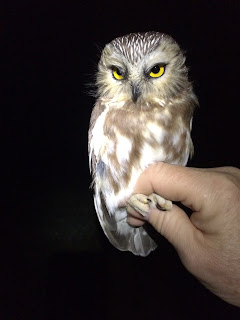This year marked the second year of operating the Project Owlnet station in Boyce-Mayview Park, located in Upper St. Clair. Despite an early large movement of owls to our north, it was a slow season for banding the species through the Appalachian area. However, this year we banded four Northern Saw-whet owls in the park, all of them females. We had numerous visitors to the park to see the process. Some of these visitors were lucky enough to see an owl, and some were not. Attempting to catch and band Northern Saw-whet Owls requires a lot of patience!
As you may know, these small owls (our smallest owl species in this area) migrate from the boreal forest in Canada to areas south for the winter. There are some breeding populations in the higher elevations of West Virginia and Central Pennsylvania, however, most birds are coming from the boreal forest and continuing south to find food in the fall. The peak of the migration for our area seems to be right around Halloween through mid-November. Last year, our first owl was caught on the night of 29 October; this year our first owls showed up in our nets on 2 November, when it was a two-owl night.
We capture and band these birds in order to better understand their migration and factors which may affect their migration. As with any other bird which is netted, biometric information such as mass, wing length, age and sex is gathered without harm to the bird. Birds are banded and released to continue on their way. The data we collect is pooled with other stations' information in order to further study this secretive migrant of the night.

An adult female Northern Saw-whet Owl prior to release from the station.
These owls are small, but very efficient hunters; notice the talons.
By examining the feathers, we are able, in most cases, to determine the age of the bird.
Ultraviolet light is used to examine the wing of the Northern Saw-whet Owl. Owls have a chemical in their feathers called porphyrin. Ultraviolet light reveals the amount of porphyrin in the wing; the brighter purple or pink feathers have more porphyrin than do other feathers. This tells us that the feathers are fresher than the ones with less saturation of color. Based on what we know about how this species molts its feathers, this helps us determine, rather precisely, the age of the bird.
We will be offering several public nights in the park next fall, so watch for announcements either here or through the Outdoor Classroom if you are interested in learning more about this captivating species.
















